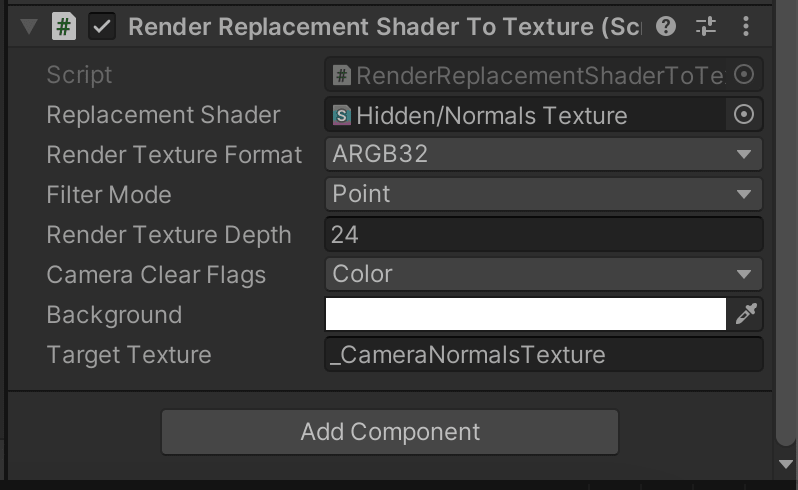Unity toon shader with outline
The goal of this tutorial is to have a unity toon shader with outline, for that we combine two shader one for creating the cel shading or toon shading and one for creating the outline. In this tutorial I make use of the shader found here.
The first thing to do to allow Unity to use the shader is to create a project with the Universal Render Pipeline, by default I create a 3D project with URP :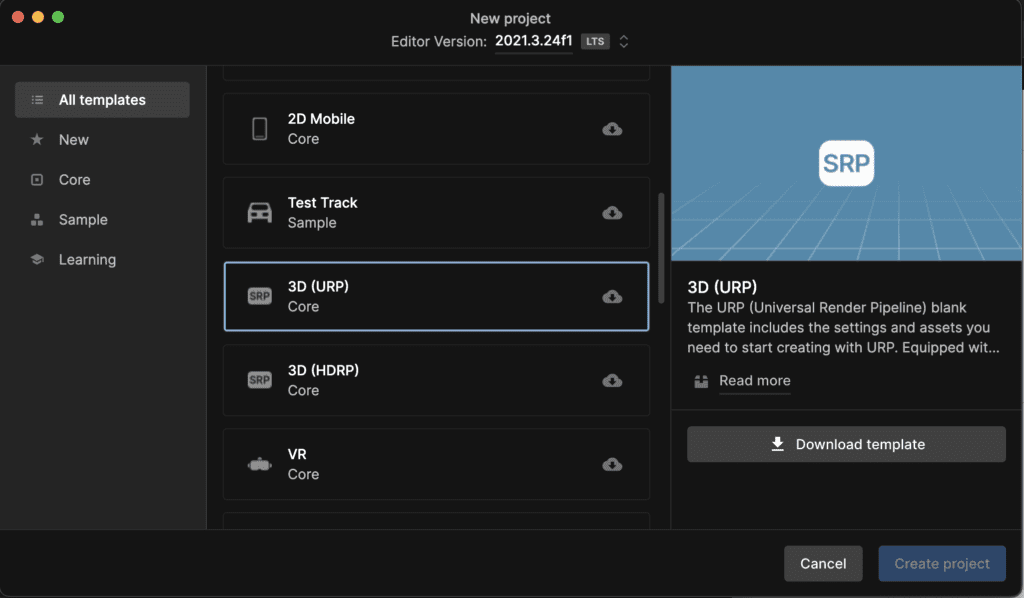
When the project creation is finished you can create the toon shader first:
Toon shader
Here is the shader we will use for the toon effect/cel shading effect, you can create a toon.shader file with the code :
Shader "Toon"
{
Properties
{
_Color("Color", Color) = (1,1,1,1)
_MainTex("Main Texture", 2D) = "white" {}
[HDR]
_AmbientColor("Ambient Color", Color) = (0.4,0.4,0.4,1)
[HDR]
_SpecularColor("Specular Color", Color) = (0.9,0.9,0.9,1)
_Glossiness("Glossiness", Float) = 32
[HDR]
_RimColor("Rim Color", Color) = (1,1,1,1)
_RimAmount("Rim Amount", Range(0, 1)) = 0.716
_RimThreshold("Rim Threshold", Range(0, 1)) = 0.1
}
SubShader
{
Pass
{
Tags
{
"LightMode" = "ForwardBase"
"PassFlags" = "OnlyDirectional"
}
CGPROGRAM
#pragma vertex vert
#pragma fragment frag
#pragma multi_compile_fwdbase
#include "UnityCG.cginc"
#include "Lighting.cginc"
#include "AutoLight.cginc"
struct appdata
{
float4 vertex : POSITION;
float4 uv : TEXCOORD0;
float3 normal : NORMAL;
};
struct v2f
{
float4 pos : SV_POSITION;
float3 worldNormal : NORMAL;
float2 uv : TEXCOORD0;
float3 viewDir : TEXCOORD1;
SHADOW_COORDS(2)
};
sampler2D _MainTex;
float4 _MainTex_ST;
v2f vert (appdata v)
{
v2f o;
o.pos = UnityObjectToClipPos(v.vertex);
o.worldNormal = UnityObjectToWorldNormal(v.normal);
o.viewDir = WorldSpaceViewDir(v.vertex);
o.uv = TRANSFORM_TEX(v.uv, _MainTex);
TRANSFER_SHADOW(o)
return o;
}
float4 _Color;
float4 _AmbientColor;
float4 _SpecularColor;
float _Glossiness;
float4 _RimColor;
float _RimAmount;
float _RimThreshold;
float4 frag (v2f i) : SV_Target
{
float3 normal = normalize(i.worldNormal);
float3 viewDir = normalize(i.viewDir);
float NdotL = dot(_WorldSpaceLightPos0, normal);
float shadow = SHADOW_ATTENUATION(i);
float lightIntensity = smoothstep(0, 0.01, NdotL * shadow);
float4 light = lightIntensity * _LightColor0;
float3 halfVector = normalize(_WorldSpaceLightPos0 + viewDir);
float NdotH = dot(normal, halfVector);
float specularIntensity = pow(NdotH * lightIntensity, _Glossiness * _Glossiness);
float specularIntensitySmooth = smoothstep(0.005, 0.01, specularIntensity);
float4 specular = specularIntensitySmooth * _SpecularColor;
float rimDot = 1 - dot(viewDir, normal);
float rimIntensity = rimDot * pow(NdotL, _RimThreshold);
rimIntensity = smoothstep(_RimAmount - 0.01, _RimAmount + 0.01, rimIntensity);
float4 rim = rimIntensity * _RimColor;
float4 sample = tex2D(_MainTex, i.uv);
return (light + _AmbientColor + specular + rim) * _Color * sample;
}
ENDCG
}
UsePass "Legacy Shaders/VertexLit/SHADOWCASTER"
}
}
This shader compute light with the Blinn Phong_reflection_model. After creating the shader you will need to create a material with it.
Outline Shader
The outline shader will be used on every objects after doing the post-processing.
For that you will need to have the shader HiddenNormalsTexture.shader :
Shader "Hidden/Normals Texture"
{
Properties
{
}
SubShader
{
Tags
{
"RenderType" = "Opaque"
}
Pass
{
CGPROGRAM
#pragma vertex vert
#pragma fragment frag
#include "UnityCG.cginc"
struct appdata
{
float4 vertex : POSITION;
float3 normal : NORMAL;
};
struct v2f
{
float4 vertex : SV_POSITION;
float3 viewNormal : NORMAL;
};
sampler2D _MainTex;
float4 _MainTex_ST;
v2f vert (appdata v)
{
v2f o;
o.vertex = UnityObjectToClipPos(v.vertex);
o.viewNormal = COMPUTE_VIEW_NORMAL;
return o;
}
float4 frag (v2f i) : SV_Target
{
return float4(normalize(i.viewNormal) * 0.5 + 0.5, 0);
}
ENDCG
}
}
}
But also the shader called Outline.shader :
Shader "Hidden/Outline Post Process"
{
SubShader
{
Cull Off ZWrite Off ZTest Always
Pass
{
HLSLPROGRAM
#pragma vertex Vert
#pragma fragment Frag
#include "Packages/com.unity.postprocessing/PostProcessing/Shaders/StdLib.hlsl"
TEXTURE2D_SAMPLER2D(_MainTex, sampler_MainTex);
TEXTURE2D_SAMPLER2D(_CameraNormalsTexture, sampler_CameraNormalsTexture);
TEXTURE2D_SAMPLER2D(_CameraDepthTexture, sampler_CameraDepthTexture);
float4 _MainTex_TexelSize;
float _Scale;
float4 _Color;
float _DepthThreshold;
float _DepthNormalThreshold;
float _DepthNormalThresholdScale;
float _NormalThreshold;
float4x4 _ClipToView;
float4 alphaBlend(float4 top, float4 bottom)
{
float3 color = (top.rgb * top.a) + (bottom.rgb * (1 - top.a));
float alpha = top.a + bottom.a * (1 - top.a);
return float4(color, alpha);
}
struct Varyings
{
float4 vertex : SV_POSITION;
float2 texcoord : TEXCOORD0;
float2 texcoordStereo : TEXCOORD1;
float3 viewSpaceDir : TEXCOORD2;
#if STEREO_INSTANCING_ENABLED
uint stereoTargetEyeIndex : SV_RenderTargetArrayIndex;
#endif
};
Varyings Vert(AttributesDefault v)
{
Varyings o;
o.vertex = float4(v.vertex.xy, 0.0, 1.0);
o.texcoord = TransformTriangleVertexToUV(v.vertex.xy);
o.viewSpaceDir = mul(_ClipToView, o.vertex).xyz;
#if UNITY_UV_STARTS_AT_TOP
o.texcoord = o.texcoord * float2(1.0, -1.0) + float2(0.0, 1.0);
#endif
o.texcoordStereo = TransformStereoScreenSpaceTex(o.texcoord, 1.0);
return o;
}
float4 Frag(Varyings i) : SV_Target
{
float halfScaleFloor = floor(_Scale * 0.5);
float halfScaleCeil = ceil(_Scale * 0.5);
float2 bottomLeftUV = i.texcoord - float2(_MainTex_TexelSize.x, _MainTex_TexelSize.y) * halfScaleFloor;
float2 topRightUV = i.texcoord + float2(_MainTex_TexelSize.x, _MainTex_TexelSize.y) * halfScaleCeil;
float2 bottomRightUV = i.texcoord + float2(_MainTex_TexelSize.x * halfScaleCeil, -_MainTex_TexelSize.y * halfScaleFloor);
float2 topLeftUV = i.texcoord + float2(-_MainTex_TexelSize.x * halfScaleFloor, _MainTex_TexelSize.y * halfScaleCeil);
float3 normal0 = SAMPLE_TEXTURE2D(_CameraNormalsTexture, sampler_CameraNormalsTexture, bottomLeftUV).rgb;
float3 normal1 = SAMPLE_TEXTURE2D(_CameraNormalsTexture, sampler_CameraNormalsTexture, topRightUV).rgb;
float3 normal2 = SAMPLE_TEXTURE2D(_CameraNormalsTexture, sampler_CameraNormalsTexture, bottomRightUV).rgb;
float3 normal3 = SAMPLE_TEXTURE2D(_CameraNormalsTexture, sampler_CameraNormalsTexture, topLeftUV).rgb;
float depth0 = SAMPLE_DEPTH_TEXTURE(_CameraDepthTexture, sampler_CameraDepthTexture, bottomLeftUV).r;
float depth1 = SAMPLE_DEPTH_TEXTURE(_CameraDepthTexture, sampler_CameraDepthTexture, topRightUV).r;
float depth2 = SAMPLE_DEPTH_TEXTURE(_CameraDepthTexture, sampler_CameraDepthTexture, bottomRightUV).r;
float depth3 = SAMPLE_DEPTH_TEXTURE(_CameraDepthTexture, sampler_CameraDepthTexture, topLeftUV).r;
float3 viewNormal = normal0 * 2 - 1;
float NdotV = 1 - dot(viewNormal, -i.viewSpaceDir);
float normalThreshold01 = saturate((NdotV - _DepthNormalThreshold) / (1 - _DepthNormalThreshold));
float normalThreshold = normalThreshold01 * _DepthNormalThresholdScale + 1;
float depthThreshold = _DepthThreshold * depth0 * normalThreshold;
float depthFiniteDifference0 = depth1 - depth0;
float depthFiniteDifference1 = depth3 - depth2;
float edgeDepth = sqrt(pow(depthFiniteDifference0, 2) + pow(depthFiniteDifference1, 2)) * 100;
edgeDepth = edgeDepth > depthThreshold ? 1 : 0;
float3 normalFiniteDifference0 = normal1 - normal0;
float3 normalFiniteDifference1 = normal3 - normal2;
float edgeNormal = sqrt(dot(normalFiniteDifference0, normalFiniteDifference0) + dot(normalFiniteDifference1, normalFiniteDifference1));
edgeNormal = edgeNormal > _NormalThreshold ? 1 : 0;
float edge = max(edgeDepth, edgeNormal);
float4 edgeColor = float4(_Color.rgb, _Color.a * edge);
float4 color = SAMPLE_TEXTURE2D(_MainTex, sampler_MainTex, i.texcoord);
return alphaBlend(edgeColor, color);
}
ENDHLSL
}
}
}
To set up the outline shader you need to attach to the Camera a RenderReplacementShaderToTexture.cs to the camera :
using UnityEngine;
public class RenderReplacementShaderToTexture : MonoBehaviour
{
[SerializeField]
Shader replacementShader;
[SerializeField]
RenderTextureFormat renderTextureFormat = RenderTextureFormat.ARGB32;
[SerializeField]
FilterMode filterMode = FilterMode.Point;
[SerializeField]
int renderTextureDepth = 24;
[SerializeField]
CameraClearFlags cameraClearFlags = CameraClearFlags.Color;
[SerializeField]
Color background = Color.black;
[SerializeField]
string targetTexture = "_RenderTexture";
private RenderTexture renderTexture;
private new Camera camera;
private void Start()
{
foreach (Transform t in transform)
{
DestroyImmediate(t.gameObject);
}
Camera thisCamera = GetComponent <Camera >();
renderTexture = new RenderTexture(thisCamera.pixelWidth, thisCamera.pixelHeight, renderTextureDepth, renderTextureFormat);
renderTexture.filterMode = filterMode;
Shader.SetGlobalTexture(targetTexture, renderTexture);
GameObject copy = new GameObject("Camera" + targetTexture);
camera = copy.AddComponent <Camera >();
camera.CopyFrom(thisCamera);
camera.transform.SetParent(transform);
camera.targetTexture = renderTexture;
camera.SetReplacementShader(replacementShader, "RenderType");
camera.depth = thisCamera.depth - 1;
camera.clearFlags = cameraClearFlags;
camera.backgroundColor = background;
}
}
But also a PostProcessOutline.cs :
using System;
using UnityEngine;
using UnityEngine.Rendering.PostProcessing;
[Serializable]
[PostProcess(typeof(PostProcessOutlineRenderer), PostProcessEvent.BeforeStack, "Post Process Outline")]
public sealed class PostProcessOutline : PostProcessEffectSettings
{
[Tooltip("Number of pixels between samples that are tested for an edge. When this value is 1, tested samples are adjacent.")]
public IntParameter scale = new IntParameter { value = 1 };
public ColorParameter color = new ColorParameter { value = Color.white };
[Tooltip("Difference between depth values, scaled by the current depth, required to draw an edge.")]
public FloatParameter depthThreshold = new FloatParameter { value = 1.5f };
[Range(0, 1), Tooltip("The value at which the dot product between the surface normal and the view direction will affect " +
"the depth threshold. This ensures that surfaces at right angles to the camera require a larger depth threshold to draw " +
"an edge, avoiding edges being drawn along slopes.")]
public FloatParameter depthNormalThreshold = new FloatParameter { value = 0.5f };
[Tooltip("Scale the strength of how much the depthNormalThreshold affects the depth threshold.")]
public FloatParameter depthNormalThresholdScale = new FloatParameter { value = 7 };
[Range(0, 1), Tooltip("Larger values will require the difference between normals to be greater to draw an edge.")]
public FloatParameter normalThreshold = new FloatParameter { value = 0.4f };
}
public sealed class PostProcessOutlineRenderer : PostProcessEffectRenderer <PostProcessOutline >
{
public override void Render(PostProcessRenderContext context)
{
var sheet = context.propertySheets.Get(Shader.Find("Hidden/Outline Post Process"));
sheet.properties.SetFloat("_Scale", settings.scale);
sheet.properties.SetColor("_Color", settings.color);
sheet.properties.SetFloat("_DepthThreshold", settings.depthThreshold);
sheet.properties.SetFloat("_DepthNormalThreshold", settings.depthNormalThreshold);
sheet.properties.SetFloat("_DepthNormalThresholdScale", settings.depthNormalThresholdScale);
sheet.properties.SetFloat("_NormalThreshold", settings.normalThreshold);
sheet.properties.SetColor("_Color", settings.color);
Matrix4x4 clipToView = GL.GetGPUProjectionMatrix(context.camera.projectionMatrix, true).inverse;
sheet.properties.SetMatrix("_ClipToView", clipToView);
context.command.BlitFullscreenTriangle(context.source, context.destination, sheet, 0);
}
}
This script will make use of a Post Processing profile :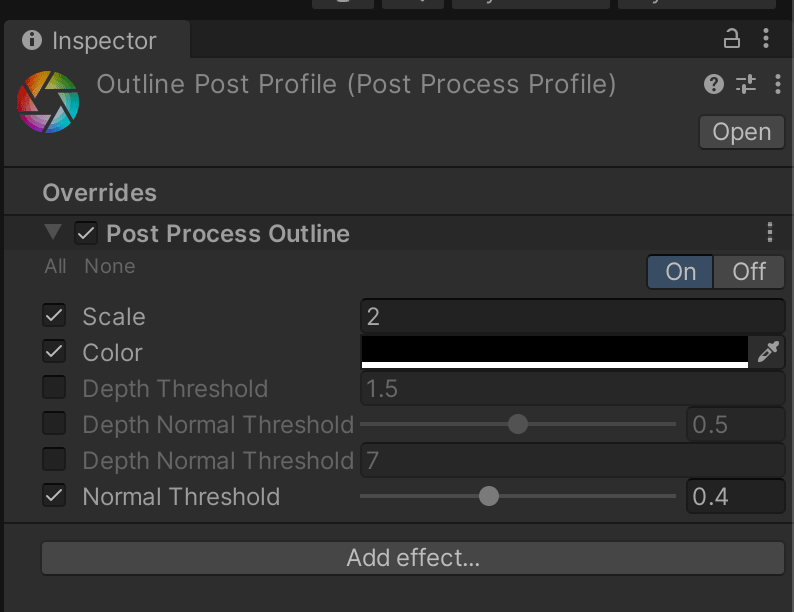
Then you need to add the following objects to the Camera :
Post process layer
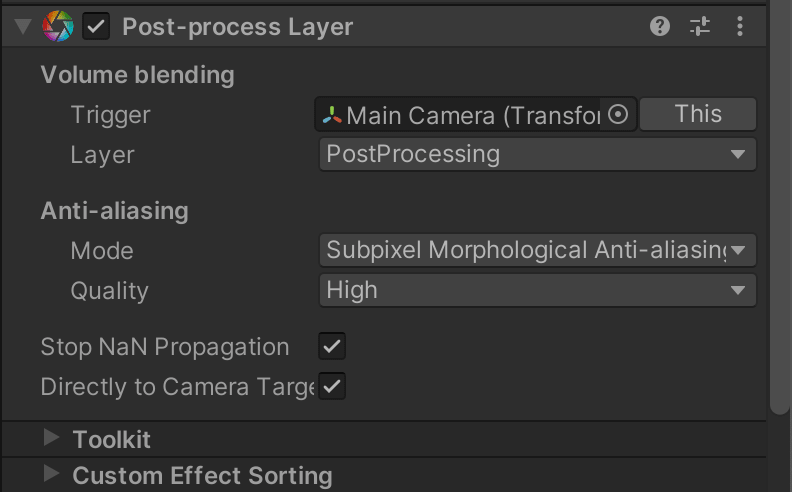
Inside the custom effect sorting you need to have the link to the post process outline :

Post process volume
The post process volume use the Outline post profile, then in the post process outline you can change the parameters of the outline shader.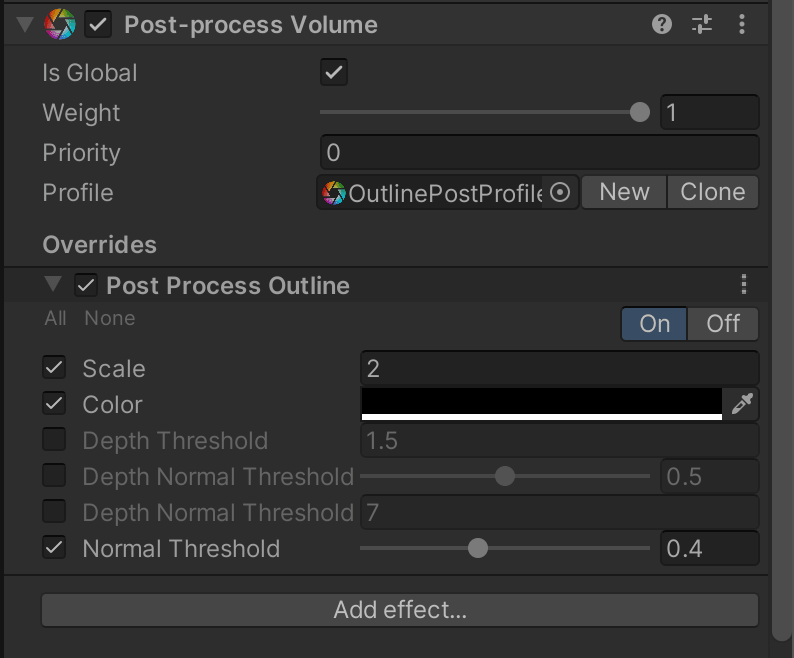
The script render Replacement shader to texture
This script use the shader NormalsTexture as an input but also the render format texture, the filter mode, the render texture depth, a color for the background a nd the target texture.